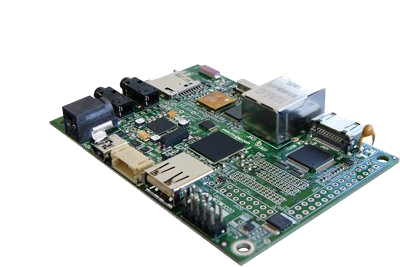Difference between revisions of "What can I do with IGEPv2"
From IGEP - ISEE Wiki
| Line 49: | Line 49: | ||
A detailed guide on how use GPIO-LEDS can be found by following this link: [[How to handle the gpio-LED]] | A detailed guide on how use GPIO-LEDS can be found by following this link: [[How to handle the gpio-LED]] | ||
| + | |||
| + | == Handle generic GPIO == | ||
| + | See [[How_to_use_GPIOs|GPIOs HOWTO]] to know details about that. | ||
| + | Quick example could be: | ||
| + | <pre>echo 156 > /sys/class/gpio/export | ||
| + | echo out > /sys/class/gpio/gpio156/direction | ||
| + | echo 0 > /sys/class/gpio/gpio156/value</pre> | ||
| + | |||
| + | <pre>echo 157 > /sys/class/gpio/export | ||
| + | echo in > /sys/class/gpio/gpio157/direction | ||
| + | cat /sys/class/gpio/gpio157/value</pre> | ||
== How to use UART1 (RS232) == | == How to use UART1 (RS232) == | ||
Revision as of 17:07, 22 September 2015
| |
| |||||||||
Overview
This is the 2/3 chapter of the Getting Started with IGEPv2 Tutorial Guide.
In this second chapter, we will learn some basics tasks. Upon completion, you will be ready to continue with chapter 3/3 that explains more advanced tasks.
Contents
[hide]
What can I do
You must logged in the board.
How to use serial console
Connect a serial (COM port) cable (known as the AT/Everex Cable) to the 10-pin header J960 on the board. Now you need a Null-Modem DB9 male-make serial cable. Connect the cable between the board and your PC. Open the serial on your PC using your preferred serial communications program (minicom) and configure the port as follows:
- 115200
- 8N1
- no flow control (either software or hardware)
Open the serial port and the debug shell prompt should appear.
A detailed guide on how to connect via serial debug port can be found by following this link: Using serial debug port to communicate
Handle the GPIO-LEDS
The board has two user bicolor (green/red) leds available that can be controlled. In its simplest form, you can control of LEDs from userspace. LEDs appear in /sys/class/leds/ and you can turn on and off with following commands:
$ echo 0 > /sys/class/leds/d240\:green/brightness
$ echo 1 > /sys/class/leds/d240\:red/brightness $ echo 0 > /sys/class/leds/d240\:red/brightness
$ echo 1 > /sys/class/leds/d440\:green/brightness $ echo 1 > /sys/class/leds/d440\:red/brightness
A detailed guide on how use GPIO-LEDS can be found by following this link: How to handle the gpio-LED
Handle generic GPIO
See GPIOs HOWTO to know details about that. Quick example could be:
echo 156 > /sys/class/gpio/export echo out > /sys/class/gpio/gpio156/direction echo 0 > /sys/class/gpio/gpio156/value
echo 157 > /sys/class/gpio/export echo in > /sys/class/gpio/gpio157/direction cat /sys/class/gpio/gpio157/value
How to use UART1 (RS232)
The board has another UART available on J960 connector (UART1). This UART is shared with RS485 so it's incompatible use both interfaces at the same time. For that reason to use UART1 for RS232 comunications you should disable RS485 interface. You can do this adding following kernel cmdline parameter
board.ei485=no
Now, you can connect the serial AT/Everex Cable to the 10-pin header J960 on the board. In that case the first pin of the AT/Everex Cable (red) should be connected to the pin number 10 of the header J960. You also need a Null-Modem DB9 male-make serial cable. Connect the cable between the target board and your PC.
Open the serial port on your PC using your preferred serial communications program (minicom) and configure the port as follows:
- 115200
- 8N1
- no flow control (either software or hardware)
On the target board open a serial port as follows:
$ microcom -s 115200 /dev/ttyS0
Now when you write a character in you PC serial port, the character should appear in the target board.
A detailed guide on how use UARTS can be found by following this link: How to use UARTs
How to use RS-485
This How-To is meant to be a starting point for people to learn to use RS-485 port on IGEP devices as quickly and easily as possible. We use IGEP YOCTO Firmware and RS485 example which describe how to setup and write data on the RS-485 port.
A detailed guide on how use UARTS can be found by following this link: How to use RS485
Get sound in (audio in)
External Audio input devices, such as a powered microphone or the audio output of a PC or MP3 player, can be connected to the via a 3.5mm jack (Audio IN).
Note that the board has been designed to use Line In for the audio input which means users need to add some type of pre-amp for a microphone to work or use a powered microphone. For a pre-amp for a microphone you can use MAX9812.
Enable capture:
amixer -c 0 sset 'Analog Right AUXR' cap amixer -c 0 sset 'Analog Left AUXL' cap
You can record audio in with the application arecord, for example:
arecord -t wav -c 2 -r 44100 -f S16_LE -v audio-in.wav
Following output is expected on console:
Recording WAVE 'audio-in.wav' : Signed 16 bit Little Endian, Rate 44100 Hz, Stereo Plug PCM: Hardware PCM card 0 'TWL4030' device 0 subdevice 0 Its setup is: stream : CAPTURE access : RW_INTERLEAVED format : S16_LE subformat : STD channels : 2 rate : 44100 exact rate : 44100 (44100/1) msbits : 16 buffer_size : 32768 period_size : 2048 period_time : 46439 tick_time : 7812 tstamp_mode : NONE period_step : 1 sleep_min : 0 avail_min : 2048 xfer_align : 2048 start_threshold : 1 stop_threshold : 32768 silence_threshold: 0 silence_size : 0 boundary : 1073741824
When ever you think you want to stop recording just press CTRL+C
Get sound out (audio out)
Connect an external output audio device to the 3.5mm jack Audio Out connector in the board, such as external stereo powered speakers.
The amplifiers for the headset output are disabled by default, so the first thing you'll do is enable these amplifiers with:
$ amixer set -D hw:0 'Headset' 0dB $ amixer set -D hw:0 'HeadsetL Mixer AudioL2' on $ amixer set -D hw:0 'HeadsetR Mixer AudioR2' on
Then you can easily play a *.wav sound with the application Aplay, for example:
$ aplay audio-in.wav
How to use wifi
If you hve a wireless network adapter in your computer you can also connect to the board using the ad hoc network connection that the firmware configures byu default.
Use your wireless manager to connect to the wireless network called in the form
IGEP_xx
After connecting, a DHCP IP address should be adquired. Now you can access, for example with ssh, to the target board connecting to the 192.168.7.1 address.
$ ssh root@192.168.6.1
A detailed guide on how use wifi can be found by following this link: Using IGEP WLAN to communicate
How to use bluetooth
A detailed guide on how use bluetooth can be found by following this link: How to setup Marvell bluetooth
How to use the SD card
You can connect a micro SD card for storage. After plugin the SD card the kernel should detect the card and automount in /media directory.
How to use the USB OTG
In order to act in host mode and add some peripherals like keyboard, mouse or pendrives you require a special cable that grounds the ID pin. Since the OTG port only provides 100mA of power a USB hub is recommended.
Though a common USB Standard-A to Mini-B type cable the port acts as a device. In this mode you can connect to the board using the USB Ethernet Gadget. Use this cable between your computer and the target board and connect with:
$ ssh root@192.168.7.1
A detailed guide on how use wifi can be found by following this link: Using USB ethernet gadget to communicate
You have successfully completed this chapter of the guide.
| |

|
If you have any question, don't ask to ask at the IGEP Community Forum or the IGEP Community Chat | 
|



